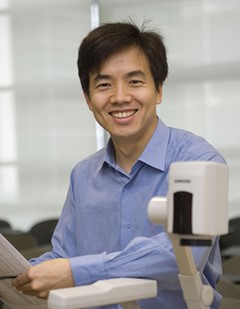报告题目:Light-Matter Interactions in Polar Semiconductor Nanomaterials
报告人:熊启华 教授
主持人:印建平 教授
时间:2018-1-24 10:30
地点:理科大楼A510报告厅
报告人简介:
熊启华是南洋理工大学数理科学学院和电气电子工程学院双聘教授。他1997年本科毕业于武汉大学物理系,2000年从中科院上海原子核所(现上海应用物理所)获得硕士学位,2006年于宾夕法尼亚州立大学获得博士学位,师从Peter C. Eklund教授。2006-2009年在哈佛大学Charles Lieber研究组从事博士后研究。2009年获得新加坡国立研究基金研究员项目资助于6月加入南洋理工大学,任南洋助理教授。2014年获得终身教职,2016年升正教授。他于2014年起担任数理科学学院副院长主管科研, 研究生教学,2017年起主要负责教职事务。熊教授的主要研究领域是以稳态和瞬态光谱学为主要实验手段,以光和物质相互作用为研究主题, 着重研究低维半导体纳米材料基于光子-声子-电子耦合作用的物理机制和量子调控。他在纳米光子学和表面等离子体学,激光制冷,以及二维半导体材料光学性质等一系列前沿课题做出了一系列有影响的工作。在《自然》及子刊, 《纳米通讯》,《先进材料》等一系列国际知名杂志上发表了180多篇文章,并被世界知名杂志及大众媒体所报道,总引用次数超过6800次,H-因子49。其出色的研究获得了一些奖励和认可,比如新加坡物理学会纳米科技奖(2015),新加坡国立研究基金NRF Investigatorship奖(2014),和南洋理工大学南洋研究卓越奖(2014)等。
Qihua Xiong received his B.S. degree in physics from Wuhan University in 1997, and then finished three years graduate studies at the Shanghai Institute of Applied Physics, Chinese Academy of Sciences. He went to the United States in 2000 and received Ph.D. degree under the supervision of Prof. Peter C. Eklund from The Pennsylvania State University in 2006. After three years postdoctoral experience in Prof. Charles M. Lieber’s group at Harvard University, he joined Nanyang Technological University as an assistant professor in 2009 and promoted to Nanyang Associate Professor in 2014. He was promoted to full Professor in 2016 recently. He is a Fellow of Singapore National Research Foundation awarded in 2009 and the inaugural NRF Investigatorship Award by Singapore National Research Foundation in 2014. He is the recipient of IPS Nanotechnology Physics Award (2015) and Nanyang Award for Research Excellence of NTU (2014). Prof. Xiong’s research focuses on light-matter interactions of emergent quantum matter by optical spectroscopy approaches. He recently ventured into the field of 2D layered materials and laser cooling of solids.

报告内容简介:
The interaction of light with matter gives rises to a wide range of linear and nonlinear phenomena that we are familiar with, such as absorption, scattering, spontaneous or stimulated emission, and second harmonic generation. In insulators or semiconductors, the electromagnetic field of light polarizes the matter leading to the formation of elemental excitations such as excitons and exciton polaritons, due to long-range dipolar force as well as additional coupling to the optical fields. In this talk, I will first introduce the background of exciton, exciton polaritons and the electron/exciton-longitudinal optical (LO) phonon interactions in semiconductors. I will then present the resolved-sideband Raman cooling of LO phonons in semiconductors using ZnTe nanoribbon as a model system. The essential picture follows a similar physical picture of cavity optomechanics, whereby the LO phonon sidebands can be tuned to be in resonant with excitonic modes. Cooling or amplification of optical phonons can be realized by changing the detuning of pump laser. Next, I will introduce our latest work on room temperature exciton-polariton lasing in all-inorganic perovskite CsPbCl3 crystals embedded in optical microcavities. Those crystals have exceptionally large exciton binding energy, strong oscillator strength and can be grown by facile epitaxy-free techniques. Polariton lasing is unambiguously evidenced by a superlinear power dependence, macroscopic ground state occupation, blueshift of ground state emission, and the build-up of long-range spatial coherence. Our work suggests considerable promise of lead halide perovskites towards large-area, low-cost, high performance room temperature polariton devices and coherent light sources extending from the ultraviolet to near infrared range. The talk will be concluded by some progress of coupling atomic-thin layered semiconductors into microcavities.
References:
1.R. Su, et al., “Room temperature polariton lasing in all-inorganic perovskites”, Nano Lett.17, 3982-3988 (2017)
2.Q. Zhang, et al., “High quality whispering-gallery-mode lasing from cesium lead halide perovskite nanoplatelets”, Adv. Funct. Mater.26, 6238-6245 (2016)
3.J. Zhang, et al., “Resolved-sideband Raman Cooling of an Optical Phonon in Semiconductor Materials”, Nature Photonics10, 600-605 (2016)
4.S.T. Ha, et al., “Laser cooling of organic-inorganic lead halide perovskites”, Nature Photonics10, 115–121 (2016)